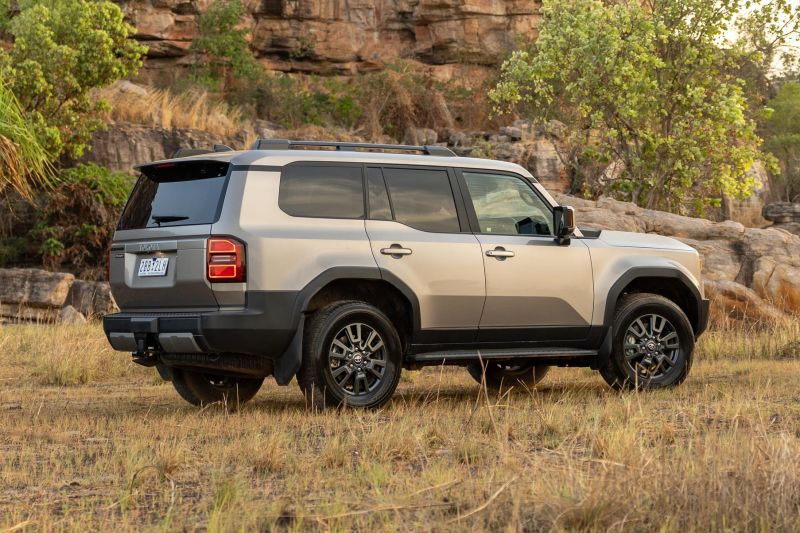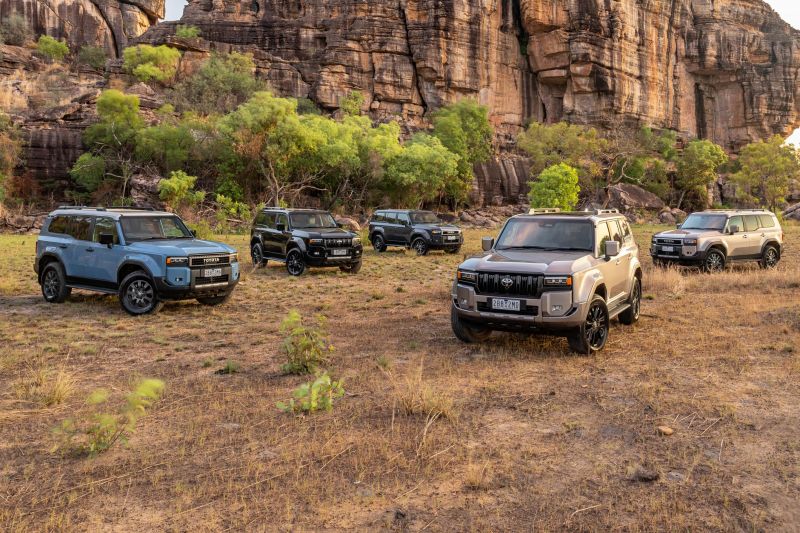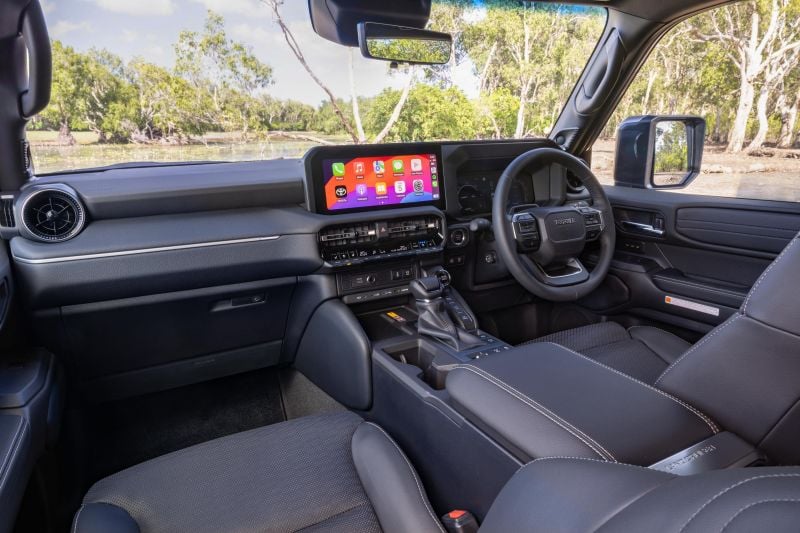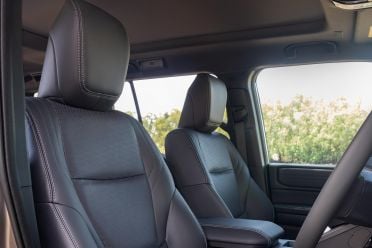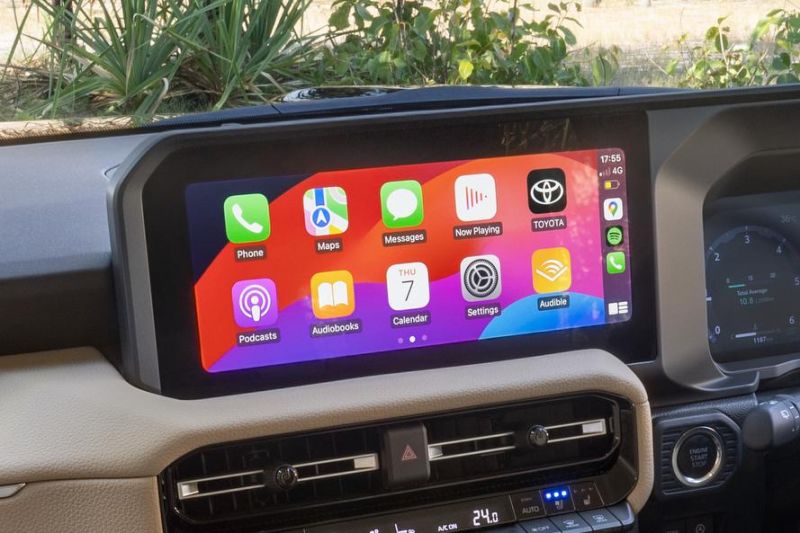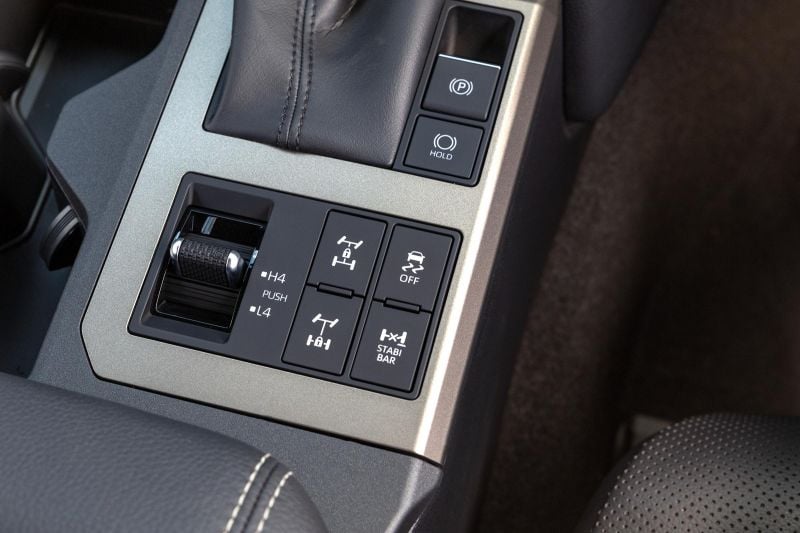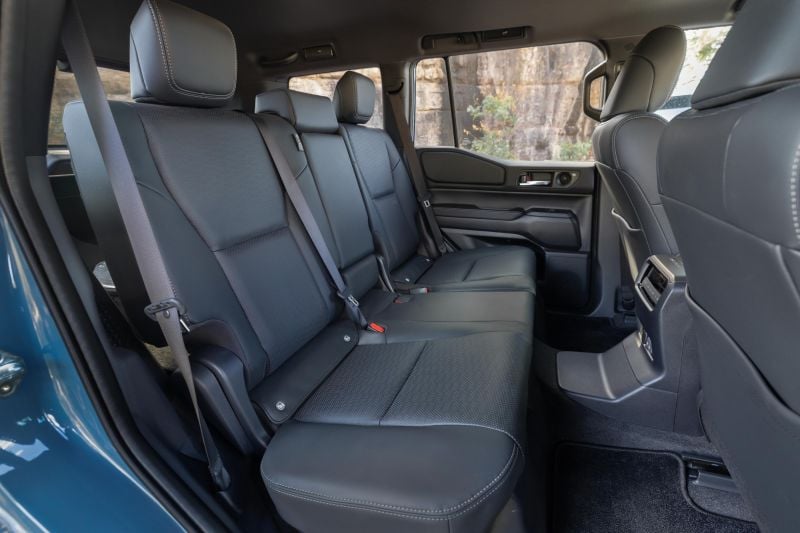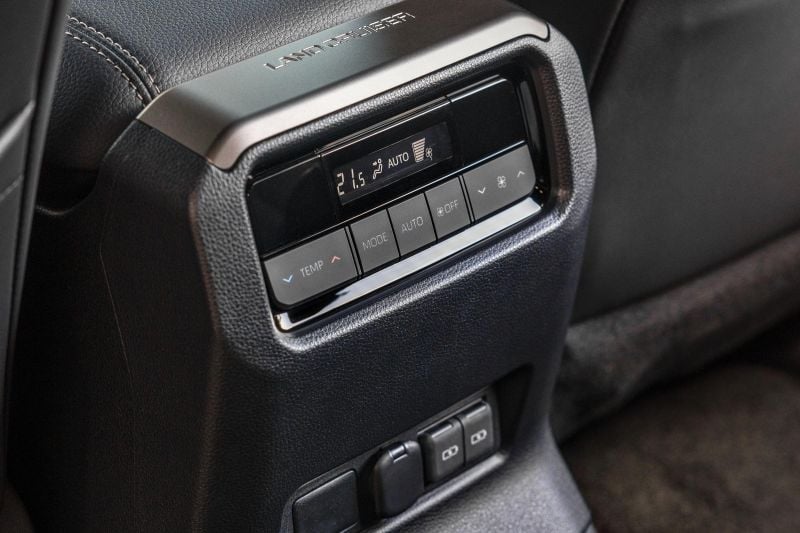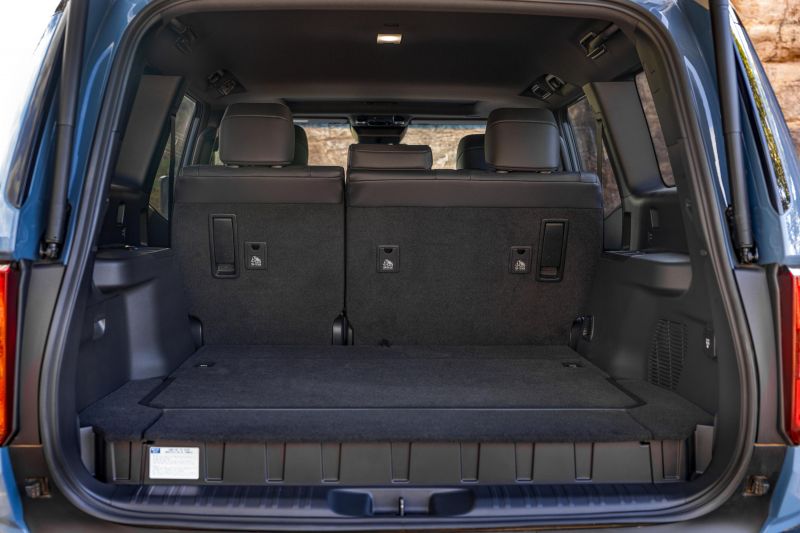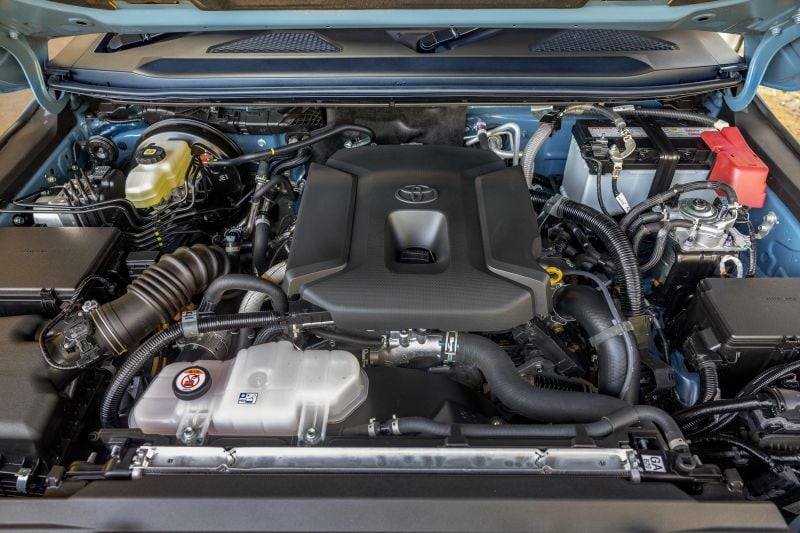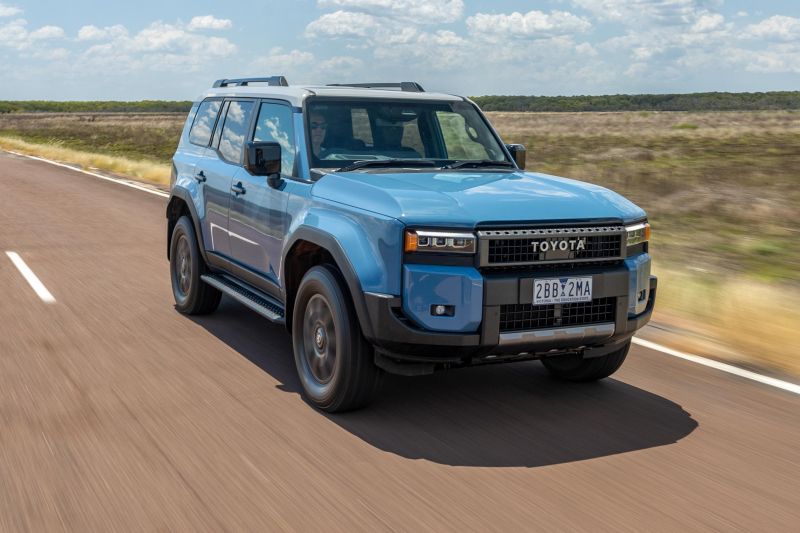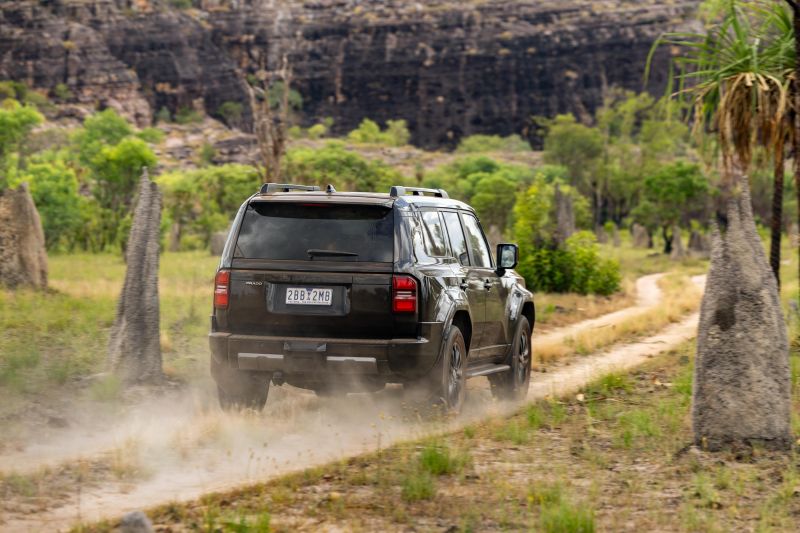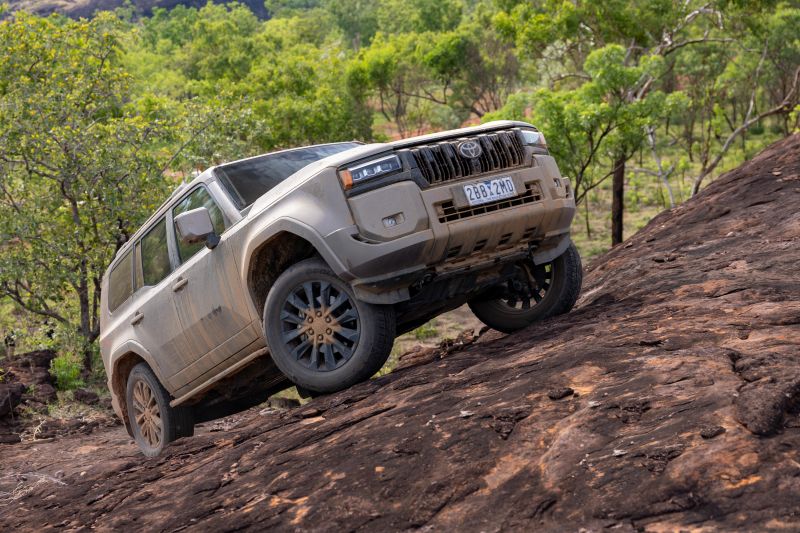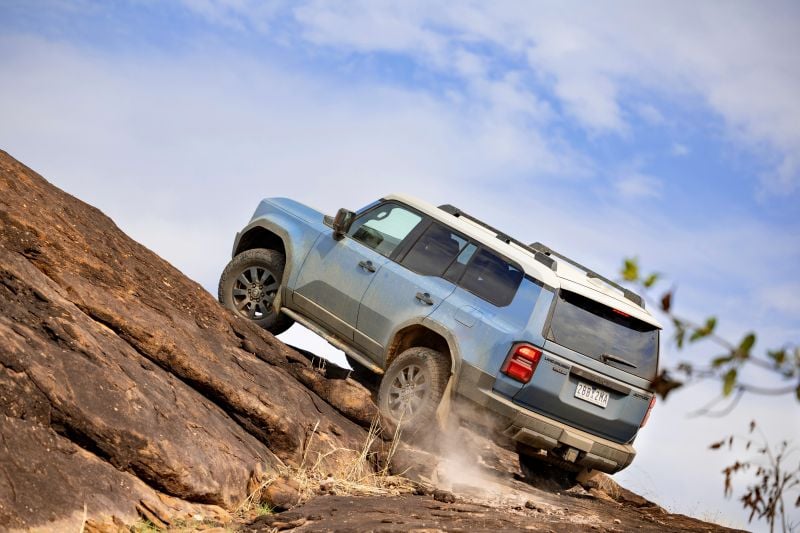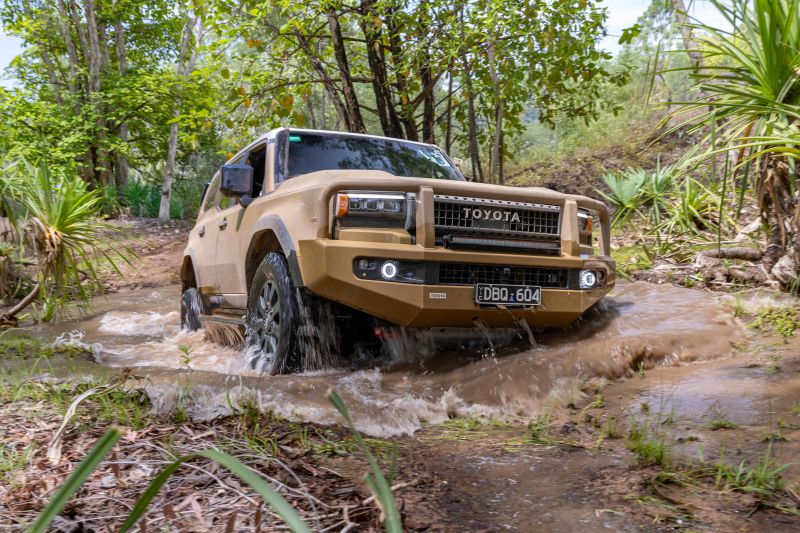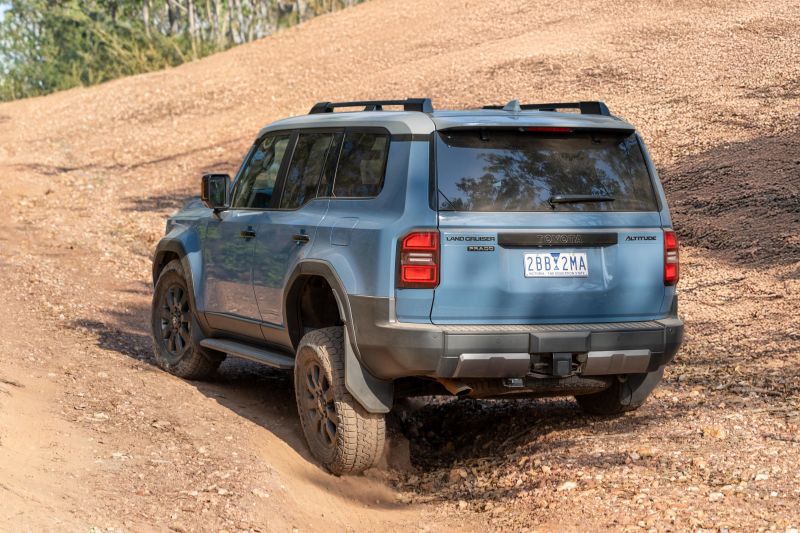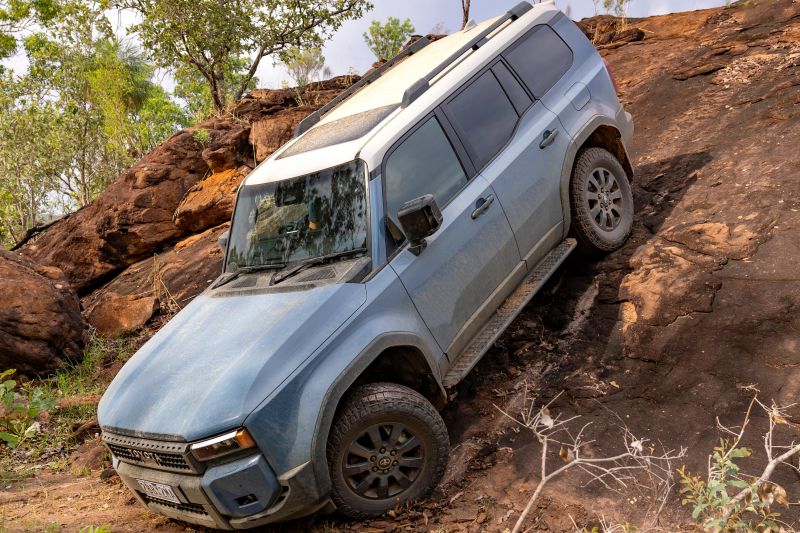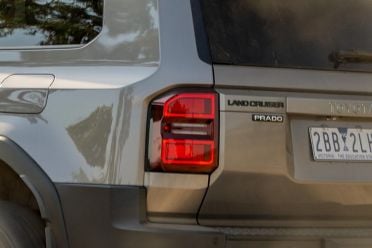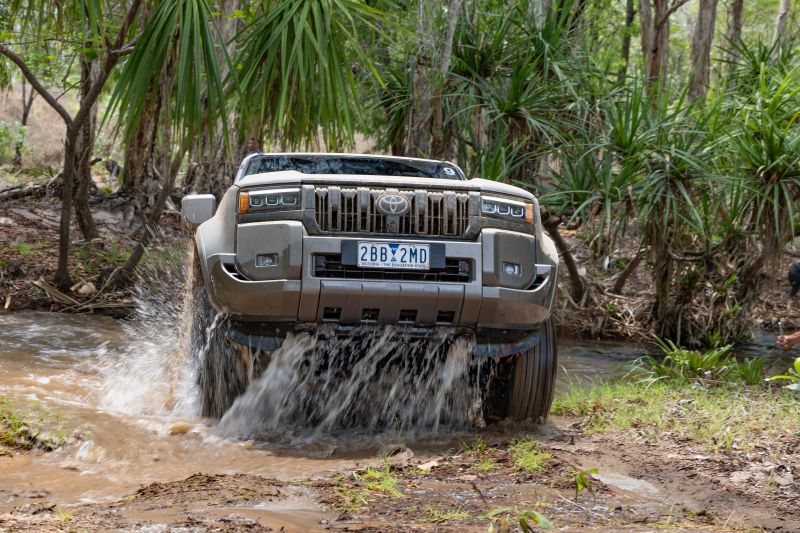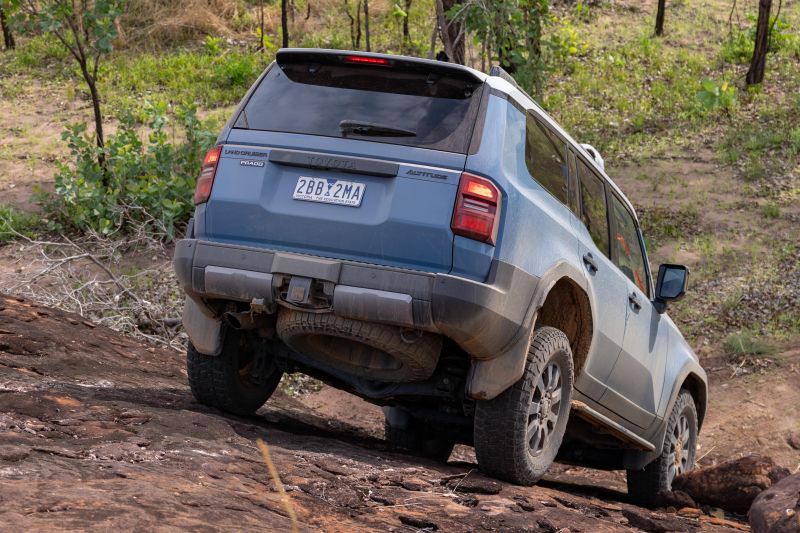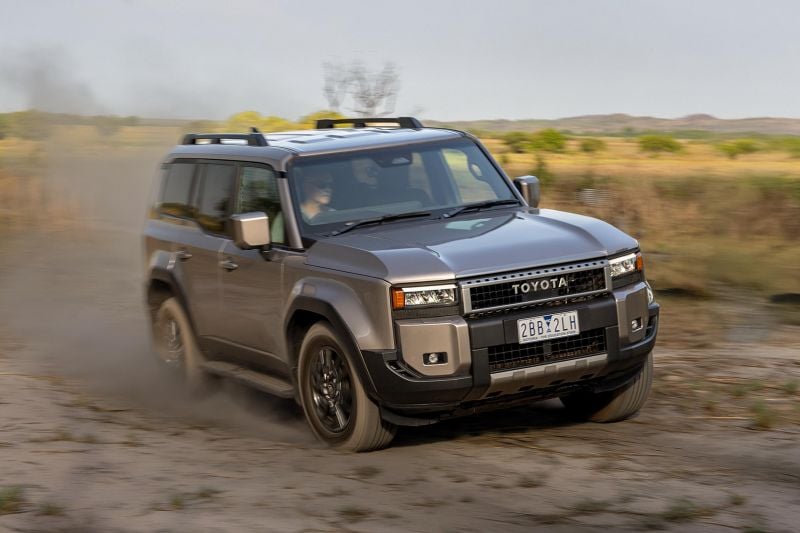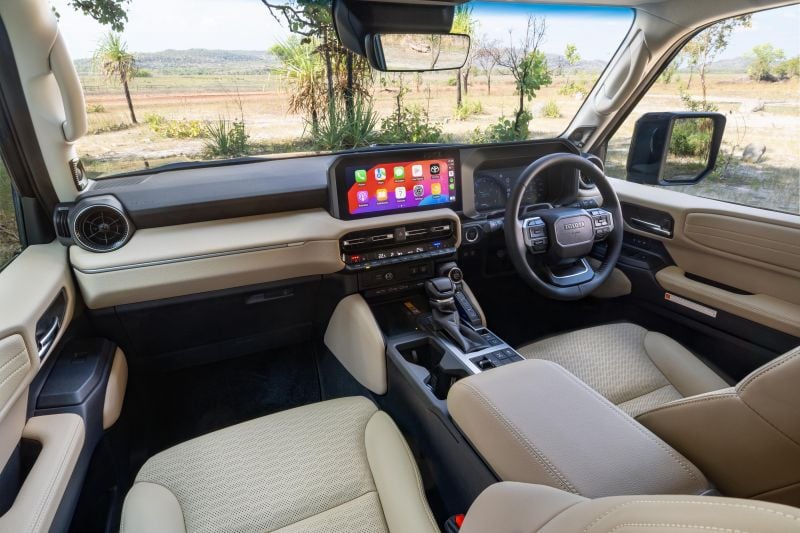Toyota Australia has finally launched its first all-new LandCruiser Prado in 15 years and, as the replacement for Australia’s most popular large SUV until earlier this year when stocks ran out, it has a lot to live up to.
The fifth-generation Prado 250 Series is a radical departure from its four predecessors not only in terms of design, but chassis architecture. For the first time, it shares the same ladder frame as its larger LandCruiser sibling, in this case the TNGA-F platform that also underpins the LandCruiser 300 Series, Tundra, Sequoia, and Tacoma, as well as the Lexus GX and LX.
While a four-cylinder petrol-electric hybrid powertrain is under consideration, from launch in Australia the 250 Series will be available exclusively with a slightly more efficient version of the same 2.8-litre turbo-diesel engine that has powered the outgoing 150 Series since 2015, but now fitted with 48V mild-hybrid assistance.
This electrified four-cylinder turbo-diesel already powers some HiLux variants, but in the new Prado it’s mated to a new eight-speed automatic transmission (up from six-speed in the old model). Drive continues to be sent through a full-time four-wheel drive system with two-speed transfer case offering high- and low-range ratios.
In addition to the mild-hybrid system – which is designed to reduce CO2 emissions by assisting acceleration, but doesn’t increase the engine’s claimed power or torque outputs – the Prado 250 Series is the first Toyota in Australia to require AdBlue diesel exhaust fluid.
WATCH: Paul’s video review of the 2025 Toyota LandCruiser Prado Altitude
Over 17,000 orders have already been taken for the new Prado and Toyota has close to 27,000 examples arriving in Australia over the first 12 months of deliveries. That guarantees maximum delivery wait times of months not years, and should ensure the new Prado will set a fresh sales record in 2025, when it should also reclaim its title of top-selling large SUV from the Ford Everest.
Whatever the case, does the new Prado 250 Series improve on the tried-and-tested formula made so popular by four ‘Son of LandCruiser’ generations dating back to 1990? We headed to the national media launch in the Northern Territory to find out.

How much does the Toyota LandCruiser Prado cost?
There are a total of five variants in the 2025 Toyota LandCruiser Prado 250 Series range, and apart from the addition of the new offroad-focussed Altitude variant, pricing is up by between $9670 and $12,522.
| Model | Price before on-road costs |
|---|---|
| 2025 Toyota LandCruiser Prado GX | $72,500 |
| 2025 Toyota LandCruiser Prado GXL | $79,990 |
| 2025 Toyota LandCruiser Prado VX | $87,400 |
| 2025 Toyota LandCruiser Prado Altitude | $92,700 |
| 2025 Toyota LandCruiser Prado Kakadu | $99,990 |
To see how the Toyota LandCruiser Prado stacks up against its rivals, check out our comparison tool
What is the Toyota LandCruiser Prado like on the inside?
The Prado 250 Series has a blocky new design that stands out. It’s funny how stylistic trends are cyclical because the almost retro styling is rather FJ Cruiser and 40 Series LandCruiser-like.
Despite being such a large, high-riding wagon, it’s pretty easy to get into thanks to the side steps and chunky grab handles. Once you’re in there’s great front and side visibility. It’s much better than the previous-gen Prado 150 Series in this regard.
Depending on the trim level the seats are upholstered in different materials. Virtually all the variants receive either faux or genuine leather seat trim, but I’m a big fan of the base GX’s fabric upholstery.
Regardless of the upholstery, the driver’s seat in all Prados feels purpose-made for long road trips. It offers great support and bolstering, and from GXL up has electric adjustment.
Another surprising feature the front seats have from GXL level up is both heating and ventilation. The latter is rare so far down in a model lineup, but was very appreciated in the sweltering heat and humidity of Kakadu.
Ahead of the driver, the steering wheel is great to hold and functional. There are plenty of physical buttons and they’re clearly labelled so you won’t be confused or wonder what they all do. That said, it took me a second to find the button that sets the cruise control.
The base GX has a plastic steering wheel which doesn’t feel very nice. This is rather common in the Prado’s entry-level competitors, though it commands a higher asking price. The rest of the range, however, has a leather-wrapped wheel which feels considerably better and more premium.
Behind the steering wheel there’s a digital instrument cluster as standard across the range, though depending on the variant its size varies. In the GX and GXL it measures 7.0-inches and looks rather similar to what the core Ford Everest and Ranger variants get.
The rest of the Prado lineup gets a full-width 12.3-inch digital instrument cluster that looks nicer and is rather high-tech.
However, both the digital driver displays offer lots of different configurations, views and layouts, and appear to be high-resolution. When you change drive modes there are cool graphics that pop onto the screen.
Moving across, there’s a large 12.3-inch touchscreen infotainment system as standard across the range. This is fantastic as it looks great and appears to pack enough processing power, making swiping through menus and opening new apps a breeze.
This infotainment system, like in many other newer Toyotas, is easy to use thanks to the simple structure. It’s hard to get lost in this system, and if you do it isn’t hard to find your way back to the home screen.
A frustration, however, is that like a number of Japanese cars many of the settings are locked when you start driving. This is to prevent you from looking at the screen for prolonged periods of time and Toyota wants you to keep your eyes on the road as much as possible.
As standard, the entire Prado range comes with both wired and wireless Apple CarPlay and Android Auto. Both look great on the touchscreen and during our testing we didn’t experience any major issues.
Thankfully, there’s a satellite navigation system built into the infotainment system, so if you’ve got no phone service you can still figure out how to get home. There’s also live traffic data and routing thanks to the embedded SIM card.
Prado GX and GXL variants come with a 10-speaker sound system as standard, and it actually punches above its weight even if the sound is a little front-biased. The rest of the range gets a 14-speaker JBL sound system that’s not overtly better – it’s just capable of being louder.
Looking around the cabin, it’s surprising how many soft-touch surfaces there are, even in the base GX. A lot of the dashboard is finished in squidgy soft-touch material that feels rather premium. Stepping up to the GXL and above, you also get deliciously soft knee rests on the centre console and door panel.
Up front, there’s a generous amount of storage space. including two sizeable cupholders, large door pockets, an adequate glove box, and a centre console box that in some variants doubles as a cool box, plus plenty of USB-C ports.
There’s also a wireless phone charger at the base of the centre stack, but it’s not flat and doesn’t have anything to secure your phone from going flying when accelerating or off-roading.
Moving to the second row, it’s easy to hop in thanks once again to the side steps and grab handles. Kids shouldn’t struggle too much, though it is a fair hike from the ground up into the cabin.
At a leggy 182cm, I had plenty of space behind my driving position. It’s worth noting the second-row seats don’t slide back and forth, but they do recline a fair way back to allow for more comfort.
In terms of second-row amenities, there are USB-C ports, map pockets, and a fold-down armrest with cupholders. All variants receive air vents in the second row, though GXL and pricier grades get a dedicated rear climate control system with roof-mounted air vents.
There are also the requisite ISOFIX child-seat anchorage points on the outboard second-row seats, plus top-tether points for all three second-row seats.
Most Prado variants, besides the GX and Altitude, come with third-row seats, taking total seating capacity to seven. The second-row seats fold and tumble to allow for third-row access, but it’s still a fair bit of effort to get back there.
It’s safe to say the Prado’s third row is not intended for adults and is much better suited to children. Although the backrest does recline, I struggled for headroom, my knees were firmly digging into the second-row seats, and it felt like my legs were very high.
Third-row amenities include USB-C ports, cupholders, and roof-mounted air vents. It’s rather plasticky back there, but thanks to the stadium-style seating layout you can see a fair bit of scenery outside, which helps to alleviate carsickness.
Around the back, the 250 Series is the first Prado to have a top-hinging tailgate instead of a side-hinged unit. This is much more carpark-friendly, though it means it’s not capable of carrying a spare wheel. All models besides the GX have a power tailgate, which beeps rather incessantly.
Like flat-tailgate versions of the outgoing 150 Series, the 250 Series comes with a rear window hatch that can open separately from the tailgate. This is great if you’re in a tight carpark and need to grab something from the boot, provided you’re tall enough to reach in.
But opening the tailgate reveals the new Prado’s weak spot, because the 48V battery for the mild-hybrid system is situated directly under the boot floor.
While this is generally fine in five-seat models as it only raises the boot floor a little and there’s still plenty of space, in seven-seat variants the third row is mounted on top of the boot floor. And unlike in the Prado 150 Series, the third-row seats don’t fold flat with the boot floor, so they stick up a considerable amount.
The seats also can’t be temporarily removed. In all fairness, this couldn’t be done in the Prado 150 Series, but at least they folded flush with the boot floor.
To counter the uneven, split-level boot floor, Toyota has fitted a removable plastic storage box that’s level with the height of third row when stowed. It’s a similar solution to what Suzuki has employed with its three-door Jimny.
But it does look rather silly and cheap. It’s disappointing Toyota hasn’t packaged the third-row better so the boot isn’t so compromised, especially because so many of the variants come standard with seven seats.
Lastly, we appreciate the fact the Prado still comes with a full-size spare wheel, given it’s a vehicle that for many people will be a highway and off-road tourer away from towns and cities, even if the spare wheel is now under the vehicle as standard.
| Dimensions | Toyota LandCruiser Prado 250 Series |
|---|---|
| Length | 4990mm |
| Width | 1980mm |
| Height | 1925mm-1935mm |
| Wheelbase | 2850mm |
| Cargo capacity | 5-seat variants 954L (5 seats) 1895L (2 seats) 7-seat variants 182L (7 seats) 906L (5 seats) 1829L (2 seats) |
To see how the Toyota LandCruiser Prado stacks up against its rivals, check out our comparison tool
What’s under the bonnet?
The 2025 Toyota LandCruiser Prado 250 Series is only being offered from launch with a slightly more efficient version of the 2.8-litre four-cylinder turbo-diesel fitted to the previous Prado 150 Series.
It features 48V mild-hybrid assistance, like the HiLux V-Active Technology, as well as AdBlue diesel exhaust after-treatment to reduce CO2 emissions. Despite this, the engine is still only Euro 5 emissions-compliant, though Toyota has confirmed it’s capable of being reworked to reach Euro 6 standards.
| Specifications | Toyota LandCruiser Prado 250 Series |
|---|---|
| Engine | 2.8L 4cyl turbo-diesel 48V MHEV |
| Motor generator | 8.4kW 65Nm |
| Total system outputs | 150kW @ 3000-3400rpm 500Nm @ 1600-2800rpm |
| Battery | 4.3Ahr li-ion |
| Transmission | 8-speed auto |
| Drive type | Full-time 4WD |
| Fuel economy (claimed) | 7.6L/100km |
| Fuel economy (as tested) | 9.4L/100km (on-road) 12.2L/100km (off-road) |
| CO2 emissions (claimed) | 200g/km |
| Emissions standard | Euro 5 |
| Fuel tank | 80L main tank 30L sub tank 17.4L AdBlue |
| Weight (kerb) | 2495kg-2595kg |
| Payload | 580kg-615kg |
| Braked towing capacity | 3500kg |
| Gross vehicle mass (GVM) | 3100kg-3200kg |
| Gross combination mass (GCM) | 6600kg |
A 2.4-litre ‘i-Force Max’ petrol-electric hybrid powertrain is available in other markets, but it hasn’t been confirmed for Australia yet.
To see how the Toyota LandCruiser Prado stacks up against its rivals, check out our comparison tool
How does the Toyota LandCruiser Prado drive?
Starting up the Prado 250 Series, you get that classic four-cylinder turbo-diesel grumble, but it’s actually quite hard to hear in the cabin thanks to the impeccable sound insulation.
Setting off, the venerable but electrified 2.8-litre turbo-diesel engine offers a good amount of power, and the small belt-driven motor generator that’s part of the 48V mild-hybrid system does noticeably improve acceleration off the mark. It also helps to smooth out any turbo lag.
You’ll be keeping up with traffic from the lights with no troubles at all, though if you load up the car with lots of people or tow a heavy trailer, progression will obviously be a bit slower. Although we didn’t get a chance to tow during our media drive program, the Prado is now rated to tow up to 3500kg (up from 3000kg in the 150 Series).
However, when you push the turbo-diesel engine, it doesn’t feel like it has much more to give in everyday driving scenarios. It doesn’t blow you away like the Ford Everest turbo-diesel V6 or the Lexus GX turbo-petrol V6, though the Prado’s noticeable turbo whistle when it comes onto boost always made me smile.
A highlight of the Prado 250 Series is its new eight-speed automatic transmission. It’s up two ratios compared to the Prado 150 Series and this is very apparent.
All the gear changes are silky smooth and keep the engine firmly within its torque band. This means the car isn’t revving out quite as much in everyday driving, making it more peaceful in the cabin.
In addition to assisting with acceleration, the belt-driven motor generator also powers the engine idle stop/start system, which helps reduce tailpipe emissions when stationary.
Like the HiLux V-Active, it’s almost imperceptible when the engine switches back on because it uses the motor generator instead of a traditional starter motor. It’s much more seamless than other non-mild-hybrid vehicles that have a less sophisticated idle-stop system.
Strangely, however, unlike the HiLux V-Active’s stop/start system, the Prado’s was very active (geddit?) and keen to switch the engine off pretty frequently when stationary, even with the air-con absolutely cranking.
When driving on-road, the Prado’s full-time four-wheel drive system makes it feel stable and secure. But it would be nice to have a rear-wheel drive mode, as in the Everest, to further reduce fuel use.
Another highlight of the Prado 250 Series is it now has an electric power-assisted steering system, instead of the hydraulic power steering system in the Prado 150 Series. The difference it provides in low-speed driving drastically improves how manoeuvrable the car is.
You no longer need biceps of steel to do three-point turns or navigate tight carparks. Instead, the steering feel is light and completely manageable without ever breaking a sweat. This benefit is also felt during tight and twisty off-road tracks, where there’s also less kickback through the wheel.
As standard, all Prado variants get front and rear parking sensors, plus a surround-view camera with pretty decent resolution. This is key because many buyers will likely use their cars as family chariots.
Like all Prados to date, the 250 Series has a suspension setup that’s fantastic at rounding off and softening harsh impacts so they don’t transmit into the cabin. It’s a perfect setup for long-distance highway cruising.
There’s a double wishbone with stabiliser bar up front, along with a four-link rigid axle with stabiliser bar at the rear. With the smaller 18-inch wheels on the GX, GXL and Altitude, it’s one of the most comfortable rides in a mainstream car.
VX and Kakadu variants pick up adaptive dampers that unlock more driving modes. In the normal drive mode it’s not quite as settled due to the larger 20-inch alloy wheels, and in the comfort drive mode it gets a little too floaty over harsher bumps.
It’s worth noting that no Prado gets air-sprung rear suspension like the outgoing 150 Series, which on some uneven surfaces could feel a little ungainly. But the all-coil 250 Series offers good road holding on all types of bitumen roads.
That said, like all off-roaders, the new Prado has its dynamic limits on-road. It gets a lean up in the bends, though it’ll happily lean on the outward rear wheel to maximum power to the ground. It doesn’t feel like it’s going to fall over quite as much as the 150 Series, or even the 300 Series, and the electric steering dials up the resistance at the tiller.
Out on the open road, the four-pot turbo-diesel does have to work harder, though it still has enough in the tank to conduct overtakes with confident. It’ll happily sit at the legal limit of 130km/h in the Northern Territory at around 2000rpm in top gear.
It’s surprising just how quiet the Prado is, even at those kinds of speeds, given the fact it’s essentially a block on wheels. This is even more impressive when you take into account the Altitude variant comes with all-terrain tyres.
But you’ve waited long enough, and now it’s time to talk about how it goes off-road. Thanks to all the clearly labelled physical switchgear in the cabin, the Prado is really user-friendly to drive way from the black stuff.
It can tackle plenty of obstacles without even having to engage 4L, is because the eight-speed automatic and full-time four-wheel drive system are both very capable straight our of the box.
If you do need to activate 4L when the going gets properly tough, all you need to do is put the car into neutral and flick a switch on the centre console. It’s so simple and doesn’t take much thought at all.
All Prado variants get a centre diff lock as standard, but the offroad-centric Altitude adds an electronic rear diff lock, and the Kakadu scores a torque-sensing Torsen limited-slip rear diff.
From VX level and up, there’s a range of multi-terrain select drive modes that change the traction control characteristics. There’s also a multi-terrain monitor that uses the surround-view camera feeds to give you a clear picture of what’s happening around the car while off-roading.
A key improvement with Toyota basing the Prado on the modular TNGA-F platform is that it improves articulation. The front stabiliser disconnect function in the Altitude takes this to the next level, and it’s a shame other variants don’t get this handy off-road hardware.
Other off-road goodies that make 250 Series effortless to drive off-road include downhill assist control and crawl control. The latter is essentially an off-road cruise control system that takes control of braking and accelerating for you at low speeds. It’s hardly a new system for Toyota, but it’s a game changer for novice off-roaders.
On the safety front, the Prado is fully loaded. The adaptive cruise control is great at keeping an appropriate distance between you and a car ahead. It also won’t slam on the brakes if a car travelling slightly faster than you cuts in front.
Another benefit is the Prado is capable of travelling with regular cruise control if you absolutely despise adaptive cruise control.
There’s lane-keep assist that doesn’t intervene unless absolutely required, and the lane centring that works as part of the adaptive cruise control system is fantastic, even on narrow and/or winding roads.
Lastly, the Prado has a driver attention monitoring system, but throughout our testing the system didn’t throw up any warnings at all, making it much better than others that are overly active.
| Off-road dimensions | Toyota LandCruiser Prado 250 Series |
|---|---|
| Track front and rear | 1664mm front 1668mm rear |
| Ground clearance | 210mm (GX, GXL) 221mm (VX, Altitude, Kakadu) |
| Approach angle | 31 degrees (GX, GXL) 32 degrees (VX, Altitude, Kakadu) |
| Departure angle | 17 degrees |
| Wading depth | 700mm |
To see how the Toyota LandCruiser Prado stacks up against its rivals, check out our comparison tool
What do you get?
The are a total of five variants in the 2025 Toyota Prado lineup.
GX highlights:
- Five seats
- 18-inch dark grey alloy wheels
- Front grille with ‘TOYOTA’ lettering
- LED headlights
- LED daytime running lights
- Folding body-coloured mirrors
- Darkened front and rear bumpers, side sills, wheel arches
- Manual tailgate
- Fabric upholstery
- Rubber floor mats
- Six-way manual driver’s seat adjustment
- 7.0-inch multi-function instrument display
- 12.3-inch touchscreen infotainment system
- 10-speaker sound system
- Wired and wireless Apple CarPlay, Android Auto
- Four USB-C ports
- Embedded satellite navigation
- DAB+ digital radio
- Toyota connected services
- Dual-zone climate control
- Downhill assist control
- Crawl control with five speed settings
GXL adds:
- Seven-seat capacity
- Roof rails
- Rear privacy glass
- Silver front and rear bumper trim
- Power tailgate
- Synthetic leather upholstery
- Heated and ventilated front seats
- Eight-way power-adjustable driver’s seat
- Leather-accented steering wheel and gear knob
- Auto-dimming rearview mirror
- Wireless charging pad
- Rear climate control
- Two extra USB-C charging ports
VX adds:
- 20-inch dark metallic alloy wheels
- Lux grade front grille
- Bi-LED headlights with dynamic auto-levelling
- Adaptive high-beam assist
- Body-coloured front and rear bumpers
- Over-fender (wheel arch) moulding
- Rear guard trim
- Leather-accented seats
- Power lumbar and memory function for driver’s seat
- Four-way power-adjustable passenger’s seat
- Power-adjustable steering wheel
- Carpet floor mats
- Refrigerated centre console
- 12.3-inch digital instrument cluster
- 14-speaker JBL sound system
- Adaptive Variable Suspension
- Five drive modes
- Multi-terrain select
- Multi-terrain monitor
Altitude adds:
- Front grille with ‘TOYOTA’ lettering
- Five seats
- 18-inch matte grey alloy wheels with all-terrain tyres
- Locking rear differential
- ‘Stabiliser disconnect mechanism’ (in place of Adaptive Variable Suspension)
- Black door handles and tailgate trim
- Black wheel arch moulding
- Sunroof
- Two-tone colours available
- Digital rear-view mirror
- Heated steering wheel
- Head-up display
Kakadu adds (over VX):
- Panoramic sunroof
- Illuminated side steps
- Heated and ventilated rear seats
- Heated steering wheel
- Adjustable driver’s seat thigh support
- Torsen limited-slip rear differential
Is the Toyota LandCruiser Prado safe?
The 2025 Toyota LandCruiser Prado is yet to receive an ANCAP safety rating.
Standard safety equipment includes:
- Nine airbags
- Front and rear autonomous emergency braking (AEB)
- Adaptive cruise control
- Lane trace assist (lane centring)
- Blind-spot monitoring
- Front and rear parking sensors
- Trailer sway control
- Trailer pre-wiring harness
- 360-degree camera
In addition, VX and Kakadu grades gain tyre pressure warning.
How much does the Toyota LandCruiser Prado cost to run?
The 2025 Prado is covered by Toyota Australia’s five-year, unlimited-kilometre warranty. Coverage for the engine and driveline can be extended to seven years if you service within the Japanese brand’s official dealer network at the required times.
Toyota has stuck with shorter six-month, 10,000km service intervals for the 250 Series, unlike rivals which have 12-month, 15,000km intervals.
| Running costs | Toyota LandCruiser Prado 250 Series |
|---|---|
| Warranty | 5 years, unlimited kilometres – vehicle 7 years, unlimited kilometres – extended engine, driveline |
| Roadside assistance | $99 per year |
| Service intervals | 6 months, 10,000km |
| Capped-price servicing | 3 years |
| Total capped-price service cost | $2340 |
To see how the Toyota LandCruiser Prado stacks up against its rivals, check out our comparison tool
CarExpert’s Take on the Toyota LandCruiser Prado
The new Toyota Prado brings back the LandCruiser’s boxy, retro design cues in a package that’s much more modern than its predecessor.
On paper, it doesn’t seem like the 250 Series is a massive improvement on the previous-generation 150 Series. It’s still only available with a four-cylinder turbo-diesel engine (with unchanged outputs), and despite being slightly more efficient it has a shorter driving range thanks to its reduce fuel capacity (down from a maximum of 150 to 110 litres).
In practice, however, the new Prado is much better than the sum of its parts, which are considerably upgraded. The TNGA-F platform makes it feel much more planted on-road, and it offers more suspension articulation off-road.
Other major benefits over the old 150 Series are the electric power-assisted steering that’s much less fatiguing than the hydraulic system it replaces, the two extra gear ratios that make everyday driving more seamless, the improved front and side visibility from the driver’s seat, and the multimedia and safety technologies that are considerably more sophisticated but make it far more user-friendly.
I don’t know if the mild-hybrid system’s potential reduction in real-world fuel consumption is worth the compromises it demands on boot capacity and payload, and it’s disappointing that Toyota has fumbled the packaging of the third-row seats, because the removable container solution looks a bit ridiculous and can’t handle much weight on top.
Despite this, the new Prado easily eclipses its forebear as one of the best and most comfortable vehicles in which to traverse Australian highways and backroads, and makes off-road driving even more effortless.
But there’s also the price to consider. You certainly pay the Toyota tax over other notable rivals, including the very accomplished Everest. A mid-range Prado GXL will cost around the same as a flagship Everest Platinum V6.
Whether it’s worth paying more for the new Prado over an equivalent Everest is a tricky question, however, and one that’s likely to require some intensive back-to-back testing to answer.
Interested in buying a Toyota LandCruiser Prado? Get in touch with one of CarExpert’s trusted dealers here
Click the images for the full gallery





